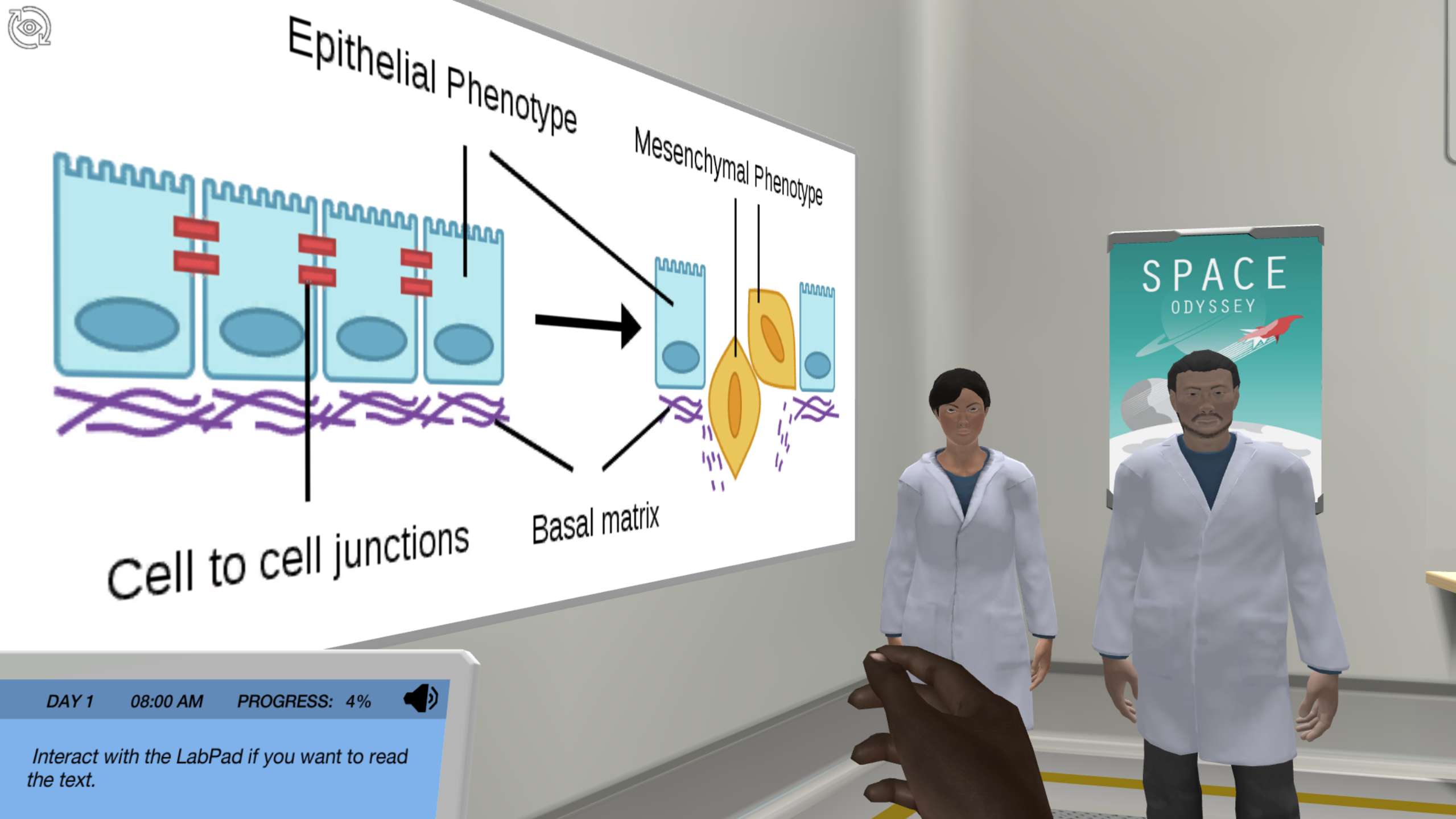Heading 1
Heading 2
Heading 3
Heading 4
Heading 5
Heading 6
Lorem ipsum dolor sit amet, consectetur adipiscing elit, sed do eiusmod tempor incididunt ut labore et dolore magna aliqua. Ut enim ad minim veniam, quis nostrud exercitation ullamco laboris nisi ut aliquip ex ea commodo consequat. Duis aute irure dolor in reprehenderit in voluptate velit esse cillum dolore eu fugiat nulla pariatur.
Block quote
Ordered list
- Item 1
- Item 2
- Item 3
Unordered list
- Item A
- Item B
- Item C
Bold text
Emphasis
Superscript
Subscript
About This Simulation
Learn how to detect the hallmarks of EMT using immunofluorescence and knock out the correct gene to revert the process using CRISPR
Learning Objectives
- Set up a protocol to get answers to a biological question related to the EMT process
- Acknowledge mistakes in the protocols and understand how to critically overcome them
- Properly prepare cells for the immunostaining procedure according to the localization of the target protein
- Select a suitable secondary antibody for an immunofluorescence experiment
- Analyze immunofluorescence results
- Describe the basics of CRISPR-Cas technique
- Design a guide RNA construct for knock-out strategies
- Evaluate CRISPR-Cas9 results
About This Simulation
Lab Techniques
- CRISPR-Cas9
- Immunofluorescence
Related Standards
- No direct alignment
- No direct alignment
- No direct alignment
Learn More About This Simulation
CRISPR may sound like a brand of cereals, but it certainly isn’t! In this simulation, you will learn to identify the molecular hallmarks of the Epithelial-to-Mesenchymal Transition (EMT) molecular process in breast cancer cells. You will induce EMT by adding TGF-beta to the cells, and, after identifying the hallmarks with immunofluorescence labeling, you will use the cutting-edge CRISPR-Cas9 technology to try to revert this process, which is one of the main causes of cancer malignancy.
Set up your own immunofluorescence protocol
In your first mission, you will be able to perform an immunostaining protocol by making decisions on the key steps of the process. Each decision can get you closer to the correct outcome, so think carefully and choose wisely!
Use CRISPR to knock out a specific gene
Once you have learned what the molecular hallmarks of EMT are, you will be able to dive into a eukaryotic cell to learn how the CRISPR-Cas9 technique works at a molecular level. Then, you will learn to design one of the CRISPR-Cas9 components by solving a fun puzzle. Last, you will select the target gene to knock out and your virtual lab assistant, Dr. One, will help you with the last part of the immunostaining process so you can directly evaluate your results.
Repeat your experiment as many times as you want
At the end of each mission, you will be able to repeat the experiment if the outcome was not the desired one, giving you the possibility of learning from your mistakes. Luckily, Dr. One will be there to help you with some of the tasks. In the end, you will be able to complete an experiment that takes weeks in just less than one hour!
Will you be able to set the right protocols in place, solving any issues that arise, to understand the molecular changes linked to the TGF-beta induced EMT and evaluate the possibility of using CRISPR-Cas9 as a possible therapeutic approach in breast cancer?
For Science Programs Providing a Learning Advantage
Boost STEM Pass Rates
Boost Learning with Fun
75% of students show high engagement and improved grades with Labster
Discover Simulations That Match Your Syllabus
Easily bolster your learning objectives with relevant, interactive content
Place Students in the Shoes of Real Scientists
Practice a lab procedure or visualize theory through narrative-driven scenarios


FAQs
Find answers to frequently asked questions.
Heading 1
Heading 2
Heading 3
Heading 4
Heading 5
Heading 6
Lorem ipsum dolor sit amet, consectetur adipiscing elit, sed do eiusmod tempor incididunt ut labore et dolore magna aliqua. Ut enim ad minim veniam, quis nostrud exercitation ullamco laboris nisi ut aliquip ex ea commodo consequat. Duis aute irure dolor in reprehenderit in voluptate velit esse cillum dolore eu fugiat nulla pariatur.
Block quote
Ordered list
- Item 1
- Item 2
- Item 3
Unordered list
- Item A
- Item B
- Item C
Bold text
Emphasis
Superscript
Subscript
A Labster virtual lab is an interactive, multimedia assignment that students access right from their computers. Many Labster virtual labs prepare students for success in college by introducing foundational knowledge using multimedia visualizations that make it easier to understand complex concepts. Other Labster virtual labs prepare learners for careers in STEM labs by giving them realistic practice on lab techniques and procedures.
Labster’s virtual lab simulations are created by scientists and designed to maximize engagement and interactivity. Unlike watching a video or reading a textbook, Labster virtual labs are interactive. To make progress, students must think critically and solve a real-world problem. We believe that learning by doing makes STEM stick.
Yes, Labster is compatible with all major LMS (Learning Management Systems) including Blackboard, Canvas, D2L, Moodle, and many others. Students can access Labster like any other assignment. If your institution does not choose an LMS integration, students will log into Labster’s Course Manager once they have an account created. Your institution will decide which is the best access method.
Labster is available for purchase by instructors, faculty, and administrators at education institutions. Purchasing our starter package, Labster Explorer, can be done using a credit card if you are located in the USA, Canada, or Mexico. If you are outside of North America or are choosing a higher plan, please speak with a Labster sales representative. Compare plans.
Labster supports a wide range of STEM courses at the high school, college, and university level across fields in biology, chemistry, physics, and health sciences. You can identify topics for your courses by searching our Content Catalog.















